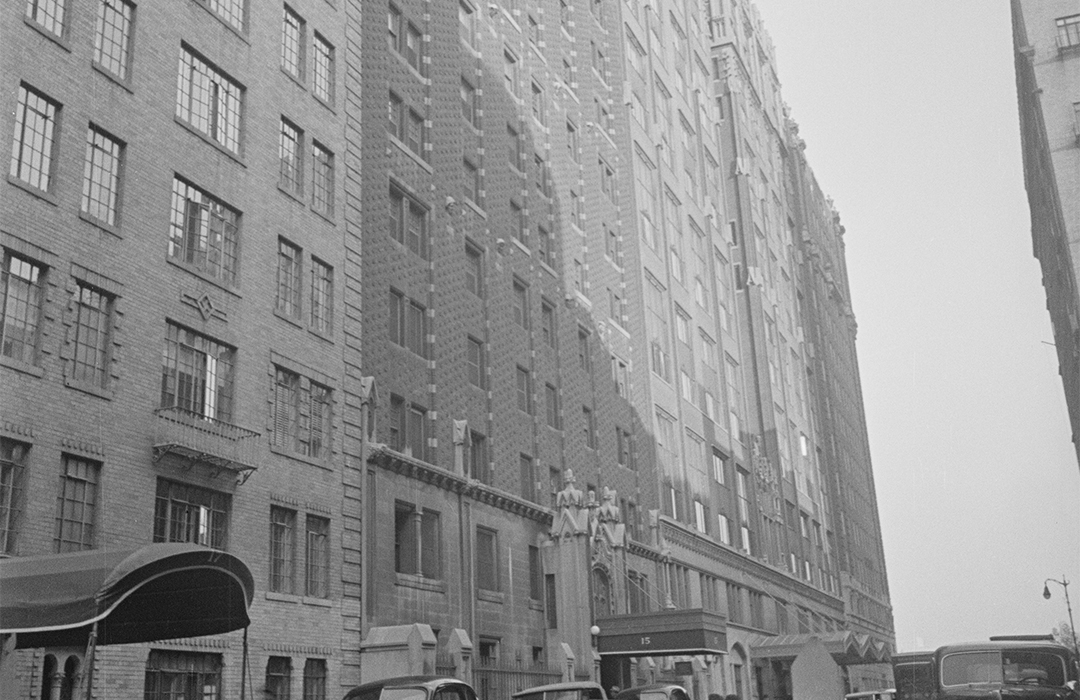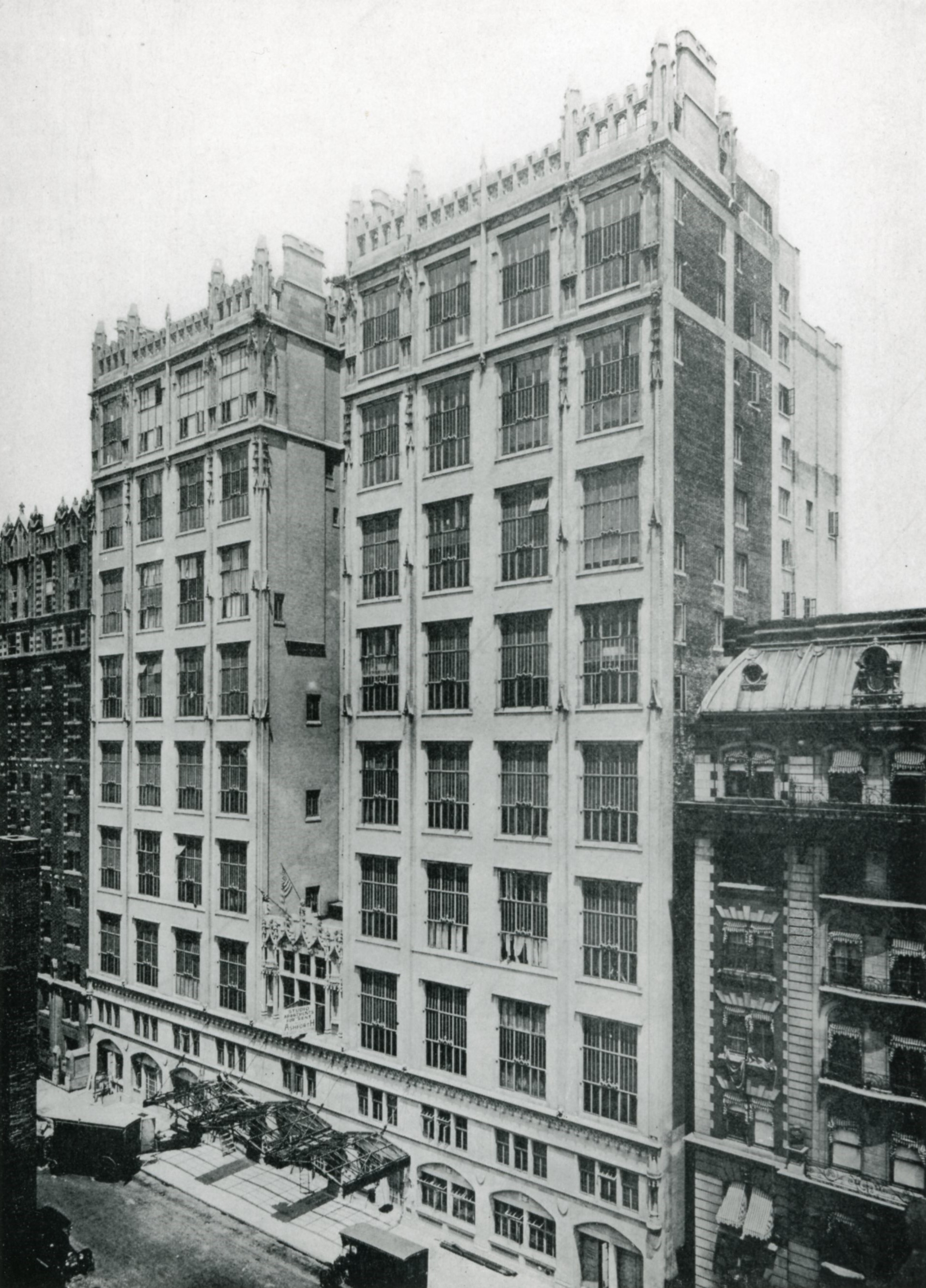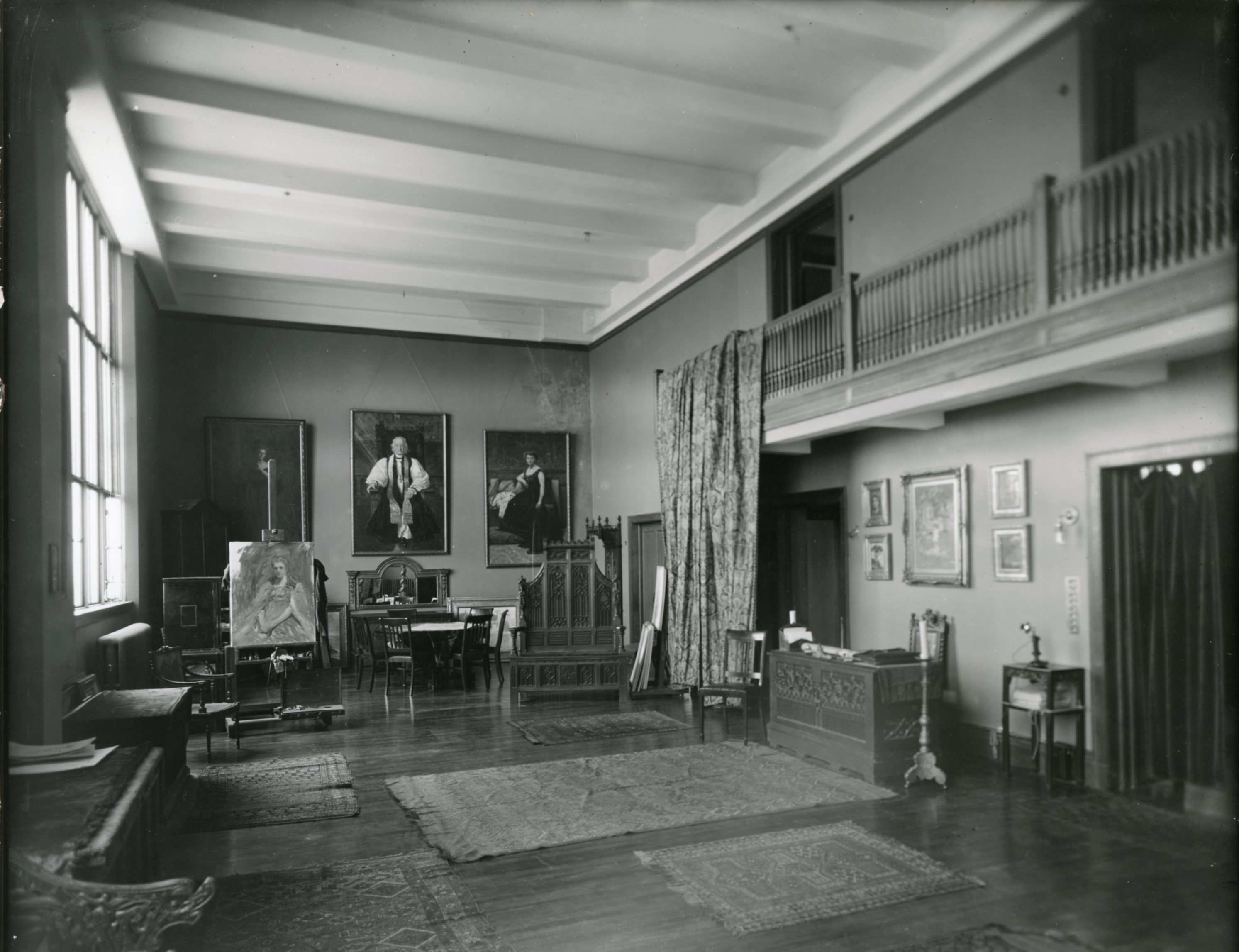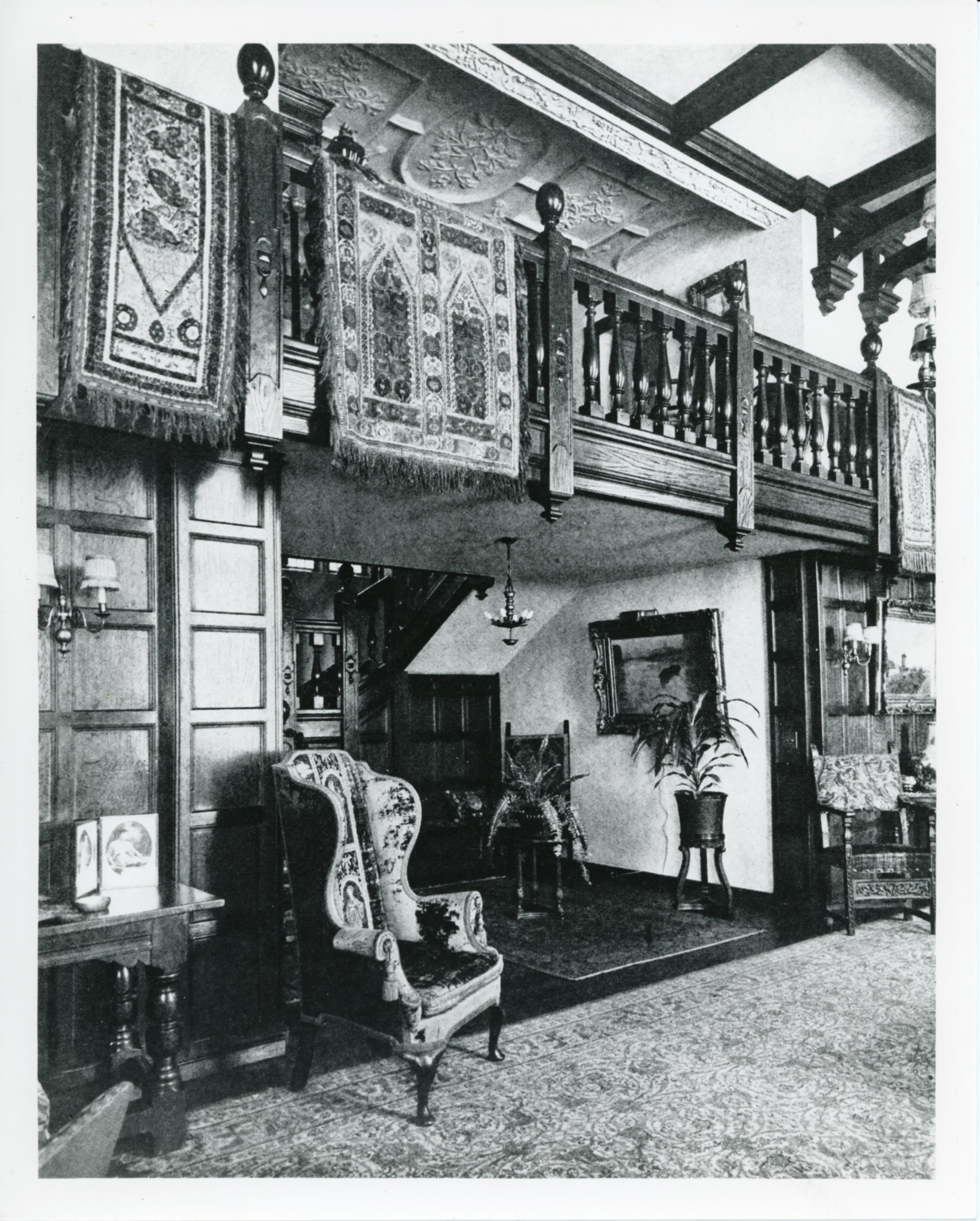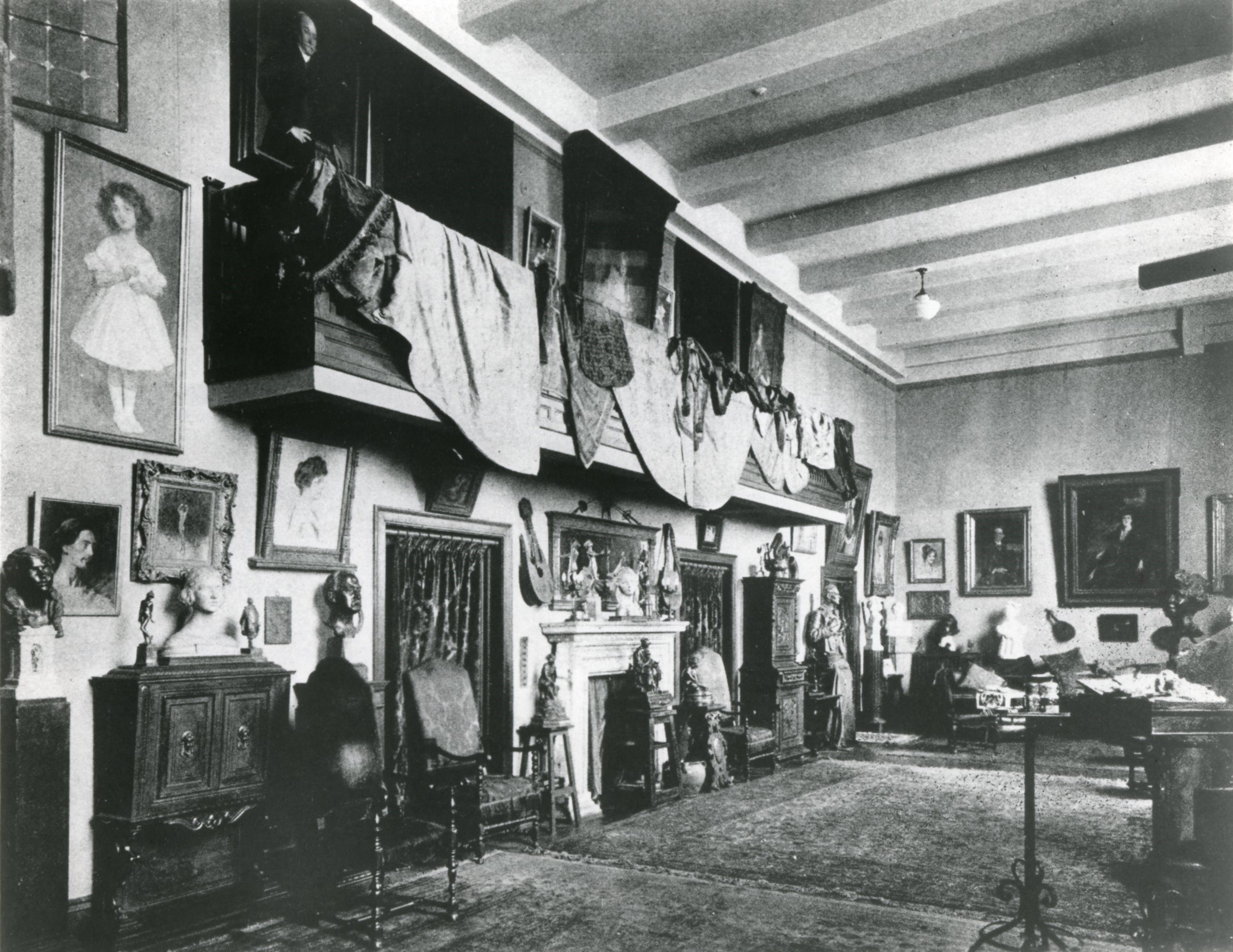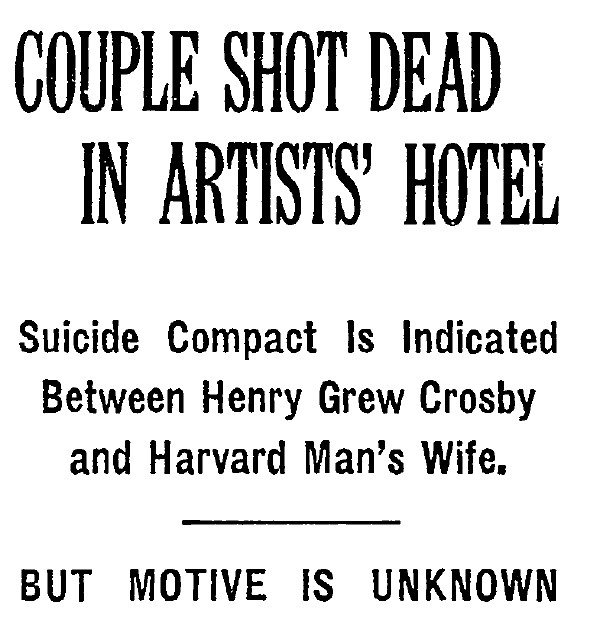
The Hotel des Artistes: 1 West 67th Street
by Megan Fitzpatrick
In 1917, the Hotel des Artistes was one of the last of the grand studio buildings to be constructed on West 67th. Walter Russell and a cooperative of artists were invested in creating purpose-made living and working spaces for artists. This idea came from American artists, disillusioned with American life and an aspiration to obtain that bohemian, Parisian lifestyle they had a taste of while studying or traveling. They commissioned a number of studio buildings on West 67th Street, and created a unique ensemble of apartments with large industrial sash windows, often north-facing, and two-, sometimes three-story living rooms. At the time of its construction, it had the distinction of more apartments of this type than any other street in the world.
West 67th Street was just another undeveloped street at the time, and despite this, the cooperative had a difficult time convincing bankers to take them up on their venture. “How could artists expect to succeed where businessmen failed?” a banker told them after they enquired about investment on the first building, No. 23-27. Their response took the investors by surprise, “Everything lasting in the world was given to it by artists.” This salient point launched the construction of studio buildings on the soon-to-be-known artist’s block.
The name Hotel des Artistes came from a French school of painting in a small provincial village that many of the founding cooperative artists had visited, including Penrhyn Stanlaws and Walter Russell. The addition of ‘hotel’ in the name was also significant as it allowed the developers to bypass certain building height restrictions.
Stanlaws is credited with creating the des Artistes, listed as the owner in 1914; however, as head of the artist syndicate, Russell was also regarded as its maker. He even listed himself as “the builder” of the studio building on labels in his museum in Virginia. Stanlaws was, however, much more hands-on in the development of the Hotel. He commissioned Brooklyn-born architect George Mort Pollard to design the building. Along with his firm partners B. Hustace Simonson and Joseph Steinem, he also designed 15 West 67th Street. He borrowed Gothic elements from this building and applied them to des Artistes, incorporating Tudor ornamentations contributing to an overall medieval appearance of the building.
On the heavily decorated front facade, features Gothic arches and pinnacles as well as almost 100 sculpted heads and gargoyles straight from a Gothic nightmare, and sculpted busts of artists from different disciplines. The medieval theme is carried on in the interior of the building, with handcrafted wood-paneled walls and dark ironwork details. The nine-story apartment building boasted an exhibition hall, large dining room, a cafe on the first floor, a large kitchen with “a score of chefs” serving each apartment and the oldest modern amenities in the city, a swimming pool and squash court. The squash court is allegedly the oldest in the world.
Stanlaws received the keys for the finished building in 1917, and tenants began filing into the lobby under its distinct glass awning.
At the time this was probably one of the most generous apartments in New York. However, she would later describe her home as a “daunting, cavernous place”
By the 1920s, many artists of various mediums lived there including actors, dancers, sculptors, painters, illustrators, photographers, and mask makers. Many non-artists and art collectors also took up residence here.
Aaron and Nettie Naumburg claimed their stake in the Hotel des Artistes like no one else. Aaron Naumburg made his fortune in fur dealing, rising to become the president of both Jones & Naumburg Corporation and the Hatters’ Fur Cutters Association and amassing a $7 million fortune. Naumburg used his fortune to collect art and become a philanthropist. With his wealth, he was also able to design his grand triplex apartment at the des Artistes.
Naumburg approached Stanlaws and asked for the largest apartment in the building, the penthouse. He recruited his own architect, William Tachau, to design the couple’s 6,000-square-foot penthouse. Construction began in 1916 but the 14-room triplex wouldn’t be completed until 1922. The novelty of this apartment, and indeed of the whole studio building, is that those who purchased apartments in the Hotel did so by buying a certain amount of cubic feet to be arranged, however, the owner wanted. This led to apartments of unique ceiling heights and arrangements, particularly the Naumburg’s apartment, which has 22-foot high ceilings.
They filled the rooms with expensive artworks, including Rembrandt’s Portrait of an Old Man, the finest furniture, and Persian and Turkish rugs. Naumburg installed a ‘secret room’ mostly used for entertainment. It became known as the “card room” or the Italian casino and was fashioned like a small European chapel with gothic arches above the doors and windows and stained glass windows, which, when closed, would highlight the intended atmosphere of the small room.
The Naumburg’s apartment was so carefully designed and planned with such a curated art collection that it ought to be preserved in a museum. Well, they thought so too. Aaron died in Italy in July 1928, and Nettie just two years later, however, following her husband’s untimely death, Nettie began to transport their apartment and art collection to a permanent place, where it would remain intact. Nettie donated the interior of the triplex along with $100,000 and a further $25,000 for the collection’s upkeep to the Fogg Museum in Harvard. Some of their personal collections remained with her, like the Rembrandt painting.
The massive triplex apartment, now gutted, stood vacant until author Fannie Hurst acquired it in 1934. Hurst came to New York, just before WWI, an ambitious aspiring writer and tried her luck to find cheap accommodation in the city. She wound up at the Three Arts Club on West 85th Street, an all-women’s apartment building for students of the arts, but she was unceremoniously kicked out after the manager of the club accused her of entering “under false premises as a dramatic artist.” Apparently, being an author was not qualifying enough to rent a room in the Three Arts Club, but years later, she gained the authority, and the wealth, to buy the penthouse apartment at the Hotel des Artistes.
Hurst, along with her Russian pianist husband, Jacques Danielson, moved into the penthouse because she claimed she needed more space. At the time, this was probably one of the most generous apartments in New York. However, she would later describe her home as a daunting, cavernous place”, that swallowed her “simple furniture at a gulp, leaving us with a vacuum of great reaches of bare floors to ceiling windows.” Hurst used the Gothic “card room” as her workroom and no doubt she wrote her best-selling drama Back Street in that sequestered ‘secret room.’
Hurst lived there until her death in 1968, and the apartment remained vacant once again until painter Valerie Markwood bought it for $120,000. This bargain was under the asking price because, at the time, the space was allegedly in a derelict state with broken blinds and pools of water on the floor. To her annoyance, she could not shake the ghost of Fannie Hurst in the studio building. “It took at least 10 years for people to stop introducing me as ‘the woman who bought the Fannie Hurst apartment,” she told the New York Times, and the staff at the Cafe des Artistes also sat her at Fannie’s usual seat.
The modernized penthouse was bought in 2021 for $10.1 million.
Emil Fuchs moved into the Hotel des Artistes in 1921, long after he had established himself as a portrait painter, most significantly of the British royal family, sculptor, and medalist. Originally from Vienna, Austria, Fuchs lived in London in the late 19th century but left for the US in 1915 amid rising anti-German sentiment in England. It was in England that he met Clare Sheridan, cousin of Winston Churchill and his future protégé. They became fast friends, and Sheridan would often visit Fuchs in his studio, and both shared a great interest in the arts. In his writings, he expressed a great admiration for her, noting, “For a young girl her outlook on life was rather remarkable, and despite her good looks she was never in any sense spoiled.” Their relationship was purely platonic, and Fuchs noticed in her an artistic talent. It was not surprising, then, that he supported her when she began to create pottery and later sculptures.
Days after Fuchs’ departure to New York, Clare’s husband, William Sheridan, died in a battle during WWI. In her effort to find a profession that would support her three children, she took inspiration from her friend and decided to dedicate her life to becoming a sculptor. Fuchs gave her permission to use his studio in London, and she also trained in France under John Tweed and Professor Édouard Lantéri. She garnered much of her success following a commission by the Soviet Union to sculpt some of its leaders. Her cousin, Winston Churchill, was undoubtedly furious about this and forbade her to go, but Sheridan went anyway, convinced this would make her “famous.” Her sculptures of Lenin and Trotsky gained her notoriety, but her published diary of her trip behind the Iron Curtain made her famous. On her book tour in Manhattan in 1921, Fuchs asked Sheridan to pose for him once again, as she did 15 years ago, and her portrait hung in his apartment at the des Artistes.
Fuchs enjoyed living in the des Artistes, where he displayed his huge collection of artworks. He was meticulous with his routine, he would wake up early and go fencing with his teacher on the roof above his studio and would then absorb whatever creation he was making at that time. He sometimes would remain in his apartment for weeks finishing his work. But, unbeknownst to everyone but his sister, Fuchs was terminally ill in 1928. Robert Hudovernik, author of Manhattan’s Hotel des Artistes: America’s Paris on West 67th Street, put the events of his final day together brilliantly. He writes:
“Just as Emil Fuchs meticulously planned his life and art, he planned his own death. On Sunday Morning, January 13, 1929, he got up and dismissed his secretary, Edna Sullivan, telling her he would not need her for the day. He arranged his scarlet chair next to his smoking stand on the balcony overlooking his collection of art…within sight of his last view of his world, in a place of honor above his antique fireplace, hung his treasured 1921 portrait of Clare Sheridan…with the aid of a hand mirror in his left hand to guide his arm, he placed “a $3 revolver” against his heart , pulled the trigger, and slumped forward into his scarlet chair.”
Sheridan wrote of Fuchs in her diary that he was overly sensitive and almost “too deep feeling to be able to live at all.” Sheridan is among the few, yet significant, female sculptors to frequent the Hotel. Sally James Farnham, who crafted the Simón Bolívar sculpture installed in Central Park, lived at the Hotel from 1925-1943, and Baroness Suzanne Silvercruys, the founder of the Minute Women of the USA, lived there in the 30s and 40s.
Fuchs’ tragic death wasn’t the only of its kind in the des Artistes, not even the only one that year.
Harry (born Henry) Grew Crosby was a poet, publisher, socialite, and WWI veteran with an alcohol and opium problem from Boston’s Back Bay high society. He was the product of generations of blue blood English and Dutch American families, descended from the Van Rensselaers, Schuylers, Morgans, and Grews. He met his wife Mary Phelps Jacobs (also known as Polly, and later, Caresse Crosby) in 1920 and the two began a romantic, and somewhat successful, yet tumultuous marriage.
Caresse is credited with patenting the first bra, and this is perhaps the least interesting thing about her colorful life. She left her husband, Richard Rodgers Peabody, also a WWI veteran with an alcohol problem (who ended up being the inspiration for the creation of Alcoholics Anonymous), and married Crosby, who pursued her tirelessly, sometimes desperately, threatening suicide if she did not marry him. The couple upended their life in the US to join other literary expats in Paris and live a very bohemian lifestyle with friends such as Ernest Hemingway and Henri Cartier-Bresson.
Their relationship was defined by many affairs, which later turned into a famously open marriage between them, and living life to the fullest, perhaps too much. They traveled the world, hosted parties, wrote poetry, gave each other stick and poke tattoos before it was cool, indulged in oysters and champagne almost every day, and smoked opium every day. By 1927, they set forth on their first business venture together, channeling their passion for literature by launching their publishing company Black Sun Press, which published the very first works of many literature greats such as James Joyce.
Crosby, however, was more focused on the many affairs he had going on, at one point in his life he had affairs with eight women at once. One of these women was the young Boston socialite Josephine Noyes Rotch. They met in Venice while she was shopping for her wedding dress. He wrote in his journal, “I am having an affair with a girl I met (not introduced) at the Lido. She is twenty and has charm and is called Josephine. I like girls when they are very young before they have any minds.” Josephine and Crosby had an ongoing affair until June 21, 1929, when she married Albert Smith Bigelow, a postgraduate at Harvard, but their affair continued soon after and grew in intensity. Josephine would send half-incoherent cables and letters to Crosby, eager to see him again and the pair met up again while on a visit to the US, first in Detroit, then in New York.
Crosby would often use the apartment of his friend, Stanley G. Mortimer Jr, in the Hotel des Artistes for his rendezvous with Josephine while in New York. His journal and published works describe his stay at the des Artistes: “New York J sick as a cat from the opium. 1 West 67th. I see C. I fight with J. I go to best 2707 with C.”
On December 10th, 1929, Crosby is meant to meet his wife and mother for dinner before a show at the Lyceum Theater, but he never shows up. Earlier that day, he went to his friend Stanley’s apartment with Josephine. Stanley received a sign from Crosby to leave them alone and he did, returning later in the evening around 9:30 pm but unable to open the door. It had been bolted from inside. He then asked the superintendent to break the door down, to tragically find both Crosby and Josephine with a bullet wound in each of their temples, and lying on the upper floor of his apartment.
Detectives determined that this was a murder-suicide and that Crosby had shot Josephine, potentially with her consent, and then shot himself a couple of hours later. In various accounts of their affair, through letters and stories told to friends, their relationship was tumultuous, but, it seems the pair shared a deep infatuation, which led to an unfortunate end. The day before their deaths, Josephine sent Crosby a 36-line poem with the last line reading, “Death is our marriage,” and that same day, Crosby wrote his final entry in his diary, “One is not in love unless one desires to die with one’s beloved.”
Newspaper headlines were a flurry of speculation the following day theorizing if it was a murder or a double suicide: “Crosby Poems Clew in Dual Death”; “Crosby Died for a Thrill, Say Paris, Jeering Pact”; “Poet Slew Society Sweetheat, No Suicide Pact.” Josephine’s husband Albert did not, however, believe in the suicide pact story. He believed his wife was the victim of a mad poet who turned murderer because he could not have the woman he loved. It’s hard to know for sure what went down in that apartment on the 9th floor of the des Artistes, but Albert was, however, wrong about one thing, believing that she was faithful to him.
After hearing the news of his death, the Crosby’s friends Hart Crane and Margaret Robson went to the scene of the crime at the des Artistes, and Robson said, “I remember there were policemen there, and everyone wanted to go up, but we weren’t allowed to. And I remember seeing the dial, showing the floors, going up and stopping on the ninth. Like a movie sequence, you know, of a detective story.” Poetry and fiction writer, and des Artistes resident, Margaret Widdemer, recounted her unintentionally humorous account of the night: “One evening I came back from the theater to find the foyer full of men. ‘Is it a director’s meeting?’ I asked as I went upstairs. The boy on the elevator–he was new–looked thrilled. ‘Love-nest murder!’ he said.” She would later go on and say, “Without wanting to be unsympathetic, I don’t think it was cricket to borrow a friend’s palace to do it in.”
By 1927, they set forth on their first business venture together, channeling their passion for literature by launching their publishing company Black Sun Press, which published the very first works of many literature greats such as James Joyce
Other prominent residents of the building’s early years include illustrator Norman Rockwell, dancer Isadora Duncan, literary greats Noel Coward, Carolyn Wells, and Edna Ferber, and silent film actors Mae Murray, Dorothy Dalton, and ZaSu Pitts. Filmmaker George Fitzmaurice hired many residents of the des Artistes in his films, including Italian actor Rudolph Valentino, whose name was the inspiration for the fashion brand Valentino. Mask Maker W. T. Benda, who made masks that were all the “rage” amongst dancers in theatrical shows, was a popular tenant, as was Howard Chandler Christy, designer of ‘Christy Girl’ and the murald in the Cafe des Artistes, now The Leopold.
The adjacent ABC studios made use of some of the building’s spaces such as the ballroom, which operated as a television studio in the 1950s.
The building, “the flagship of the fleet” of artist’s studios, appears remarkably unchanged overall since its construction.
References
Good Furniture, Volume 16, May 1921, pp. 245-250
Hudovernik, Robert, Manhattan’s Hotel des Artistes: America’s Paris on West 67th Street, Schiffer Publishing, 2020.
National Register of Historic Places Designation Report, June 12, 1985.
New York City Landmarks Preservation Commission, Upper West Side/Central Park West Historic District Designation Report, April 24, 1990.
New York Times, “Aaron Naumburg dies while in Italy,” July 1, 1928.
New York Times, “Couple Shot Dead in Artist Apartment,” December 11, 1929.
New York Times, “Sale of a Regal Triplex Stirs Hotel des Artistes,” March 26, 1974.
New York Times, “Rare Sale for a Tall Triplex,” September 12, 1993.
New York Times, “Streetscapes/Hotel des Artistes, 1 West 67th Street,” May 15, 2000.
Wolff, Geoffrey, Black Sun: The Brief Transit and Violent Eclipse of Harry Crosby, New York Review Books, 2012.
Megan Fitzpatrick is the Preservation Director of LANDMARK WEST!

